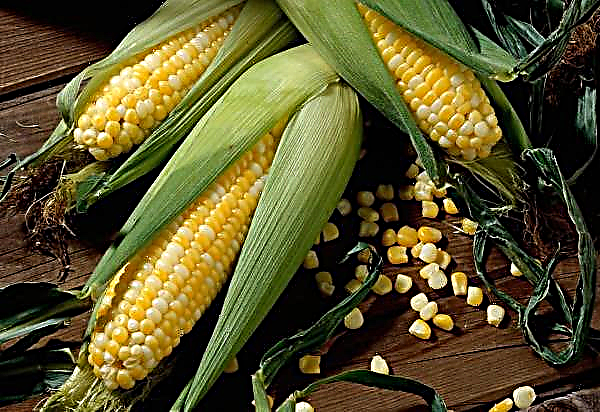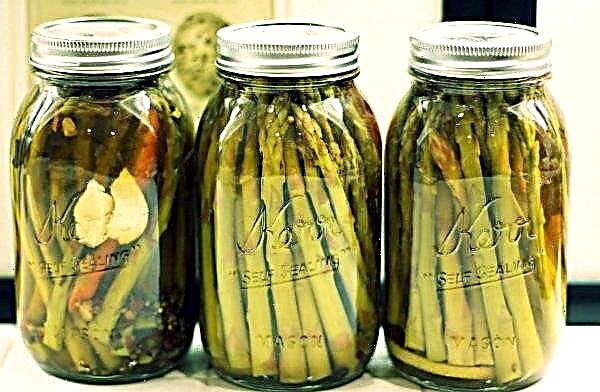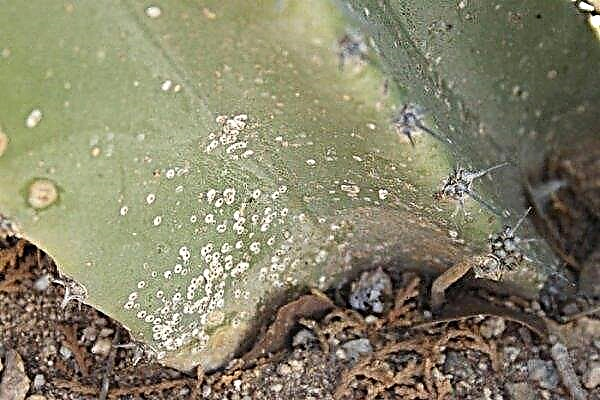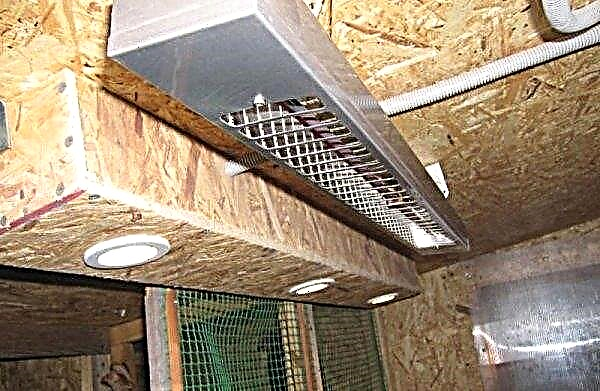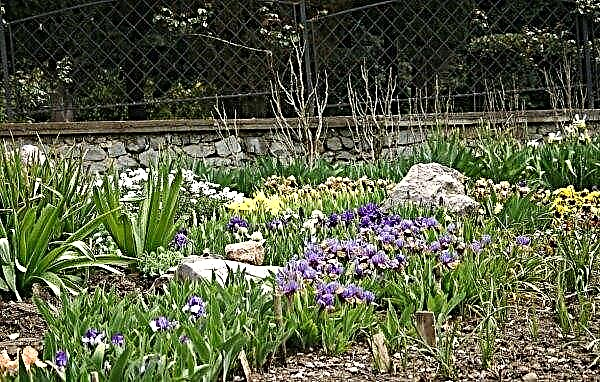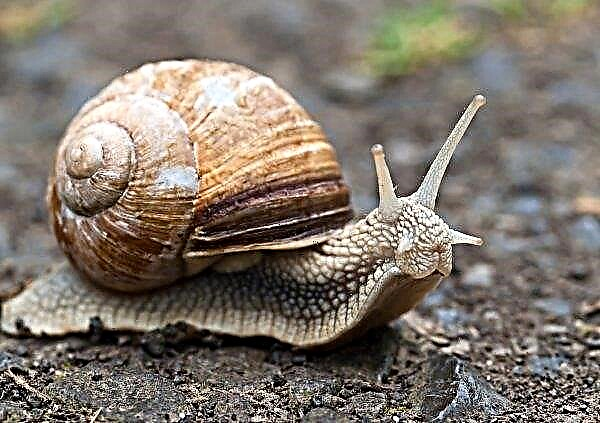Growing champignons can be quite profitable if you approach the issue with all seriousness, study the technology, calculate all the costs and estimated income, and do not forget to take into account possible risks. Demand for these mushrooms is constantly growing, as they are a very valuable product. For this reason business-The idea of raising mushrooms on home farms, in the country or in the basement today is very relevant and profitable.
Mushroom cultivation as a business
Now there are many enterprises that are engaged in mushroom growing. Among them are small households with low profitability, and large households with all the necessary industrial equipment for growing mushrooms on a large scale.
Did you know? Champignons help fight baldness due to the content in them of such an element as iron.
The technology of breeding champignons has not been a secret for a long time, so almost everyone can make money on this. The main thing is to be result-oriented and follow step-by-step production instructions. And also you need to remember to make a calculation of all investments and the estimated profitability and payback in advance. Such a mushroom as champignon, of course, is beneficial to deal with, but do not forget that it is very whimsical.
- Growing champignons for sale should be carried out for the following reasons:
- this business is not seasonal, so you can earn on it all year round;
- harvest time can be calculated with an accuracy of 3 days;
- mushrooms can be harvested up to 5 times a year;
- mushrooms can be grown in any room that can be equipped in accordance with all the rules of production;
- Compost is made from livestock waste, so it’s easier for people who have their own farm to organize a mushroom business, because they don’t have to spend money on compost materials;
- spent raw materials can be sold or used to fertilize garden and garden plants;
- if you organize the whole process at home, does not require large investments;
- Russia has a very stable demand for mushrooms, so finding markets is quite simple.

The cost of growing, productivity per 1 square meter
To understand how profitable it is to grow champignons, it is necessary to calculate the costs of their production and income from the sale. If we take as an example a small home farm, for one growing cycle it is necessary to prepare 30 tons of compost.
Costs arising in the process include the following costs:
- purchase of components for compost - 20 thousand rubles;
- the cost of mycelium is 10 thousand rubles;
- space heating and pasteurization of compost - 50 thousand rubles;
- salary for farm workers - 60 thousand rubles.
The total cost of one cycle under such conditions will be approximately 140 thousand rubles. The duration of one such cycle is approximately 2 months. From 1 m² you can get a total yield of 20 kg. The first collection wave brings about 5 kg, the second - 6 kg. Further, the performance of mycelium begins to decline. The third and fourth crops are kept at the level of 2-3 kg, and then reduced to 1 kg. A start-up company, of course, may suffer losses at first.
 But over time, subject to all the rules and the constant development of their business, it will be possible to grow a considerable crop.
But over time, subject to all the rules and the constant development of their business, it will be possible to grow a considerable crop.
Documentation whether permission is needed
It’s quite difficult to document the business of growing champignons. To do this, you need to collect a package of necessary documents, which includes:
- certificate obtained in the phytosanitary institution on the compliance of the premises with the established standards;
- radiological control document;
- certificate of quality for products indicating its validity;
- declaration of compliance with GOST requirements;
- instructions for storage and transportation of products.
Important! The quality certificate is valid only for that batch of products that was grown on one compost.
Only by submitting all these documents, you can arrange individual entrepreneurship. When you make it required:
- application for opening written in the established form;
- copy of passport (all pages);
- a document confirming that the entrepreneur has paid the state fee.
 To successfully conduct your business and make good profit, it will be more profitable to switch to a single agricultural tax.
To successfully conduct your business and make good profit, it will be more profitable to switch to a single agricultural tax.
How to choose a room
Given the sensitivity of fungi to changes in the external environment and to extraneous microflora, you need to be very responsible in choosing a room for their breeding. Improper technology for arranging a place for mushroom production can lead to a significant reduction in yield, and sometimes even to its complete loss.
For the convenience of work, the most optimal option would be to create a multi-zone system that includes four functional zones:
- A place for making and fermenting compost. Its temperature regime should be in the range of +12 ... + 16 ° С, and a good ventilation installation is necessary so that the gas products of compost fermentation are effectively removed from the room. To get about 1 ton of fertilizer, you need a place of about 20 m².
- Compost pasteurization chamber. It should be completely airtight, preferably with a separate entrance. This camera is better to do it yourself, although there are already ready-made ones on sale, but their cost is very high, so they will not pay off soon.
- The zone of sowing and cultivation of mycelium. Here the temperature is much higher than in the first part of the room in order to create optimal conditions for growth (+24 ... + 26 ° С), and air humidity must be maintained at the level of 95-100%. Of course, ventilation is also indispensable here.
- Room for growing crops. Mushrooms need a slightly lower air temperature for normal growth than for mycelium growth. It should be kept within +14 ... + 16 ° С at a humidity of 80%.

This distribution of the production area is the most optimal, while it is great for beginners in this business. If you plan to buy compost already pasteurized and prepared specifically for breeding champignons, you can refuse the first two zones. The room for mushroom cultivation must be processed so that the microorganisms contained in the air and on the walls do not spoil the whole process and reduce the yield.
Did you know? Champignons were discovered 1000 years ago in Italy.
For disinfection, such measures are carried out.:
- fumigation with sulfur checkers, followed by mandatory ventilation;
- processing a mixture of lime and copper sulfate on the walls and ceiling;
- chloroform treatment in the presence of mushroom flies in the room;
- pouring concrete on the floor to protect against high humidity, insects and rodents.
 It is desirable that in each room used for the production of mushrooms, the temperature can be adjusted depending on the purpose. It is also necessary to take care of good ventilation and additional equipment.
It is desirable that in each room used for the production of mushrooms, the temperature can be adjusted depending on the purpose. It is also necessary to take care of good ventilation and additional equipment.
Do I need some equipment
To provide the most comfortable conditions for growing champignons, it is necessary to take care of such important issues as room lighting, air exchange, temperature and humidity.
Important! Artificially grown champignons are best sold in winter and spring, and in autumn and summer the demand for them is reduced due to the appearance of forest mushrooms.
These conditions can be achieved using the following types of equipment:
- lamps for more comfortable work with beds, because for the mushrooms themselves lighting is not required;
- bactericidal quartz lamps;
- lamps for exterminating flies;
- fans for air purification from carbon dioxide and ammonia released during compost fermentation;
- fine filter;
- air coolers and humidifiers;
- automatic climate-control;
- pasteurization device;
- water heat exchanger radiator;
- thermohygrometer;
- water heater;
- pump for watering beds with water;
- cooling chamber;
- steam generator;
- straw chopper for grinding compost components.
 Also, for business development, it is necessary to acquire a hand tool for processing beds, a wheelbarrow for moving raw materials and finished products within the premises, as well as vehicles for transporting mushrooms to their destination.
Also, for business development, it is necessary to acquire a hand tool for processing beds, a wheelbarrow for moving raw materials and finished products within the premises, as well as vehicles for transporting mushrooms to their destination.
Planting material and compost: how to prepare
Horse manure is most valued for growing champignons, but in its absence, you can use cow's manure or take chicken droppings, having previously adjusted its acidity by adding chalk or gypsum.
In summer, compost can be prepared on the street, because the air temperature allows it, and in cold seasons it is worth using special chambers for fermentation, in which the temperature should not fall below +11 ... + 13 ° С. Ventilation must be installed in them to remove ammonia vapors outside.

To begin with, they take straw, moisten it well with water and mix it with manure (in equal proportions) or with chicken droppings (2: 1). A high 2-meter shoulder is formed, inside of which the temperature rises to 70 ° C. Every 4-5 days, the layers of the future compost need to be mixed so that it completely coagulates. It will be enough 5 such mixes, after which the process can be considered complete.
Next, the compost is pasteurized in a special chamber at a temperature of +60 ... + 65 ° C, or you can simply cover it with a film and let it lie down until the smell of ammonia disappears. The mass under the film will warm up to the same 65 ° C, and all harmful microorganisms and pathogenic spores will die. There is an option even easier - to buy already pasteurized compost, which is great for small mushroom farms.
Suppliers involved in the cultivation of mycelium must be selected in advance. To be sure of the quality of the products, you can sow a small area on the sample. It is not worth rushing here, because poor-quality material will lead to loss of yield, and you will suffer losses. Mycelium is cereal and compost. And if the first of them is more productive, then the advantage of the second is that it tolerates temperature differences and is resistant to pests. For beginners, compost mycelium is better.

Planting and stages of cultivation
The process of growing mushrooms directly consists of the following stages:
- Unfolding the substrate in wooden crates or bags with a layer of 20 cm and its cooling to +23 ... + 25 ° С.
- Planting grain mycelium by scattering on the surface at the rate of 500 g per 1 m² or placing compost (the size of a matchbox) in holes 4-5 cm deep in a checkerboard pattern. Both grain and compost mycelium need to be covered from above with a layer of substrate.
- The appearance of white spider webs of fungi (after 1-2 weeks).
- Falling asleep with a mixture of peat, lime and earth in a ratio of 5: 1: 4 and lowering the temperature to +12 ... + 17 ° C.
- The appearance of the first lonely mushrooms with a subsequent increase in their number (after 3-5 days).
Did you know? In champignons even more B vitaminsthan in young vegetables.
We must not forget about the conditions in which champignons should grow. Lighting for them does not matter, but moist and clean air is required, especially at the stage of forcing and growth. The first crop appears within 2-3 months after laying the mycelium.
Diseases and pests: how to protect the crop
Mushrooms can be affected by diseases that can make mushrooms unusable or not at all. There are several types of diseases for which treatment and prevention methods have been developed.
Most often there are such of them:
- White rot (mycogonosis) - rotting of the mycelium with the release of dark liquid with an unpleasant odor and deformation of the legs and caps of the fungus. For prevention, it is necessary to ventilate the room and maintain the optimum level of temperature and humidity, and still process the soil with a formalin solution. Additionally, filters for fine air purification are installed. And you also need to get rid of insects and waste substrate.

- Dry rot. It is a black and white coating on mushrooms or brown spots on hats. Infected mushrooms should be removed immediately, clean the air of harmful spores and insects and adhere to hygiene rules. If the disease has spread widely, you need to treat the fungi with systemic fungicide.
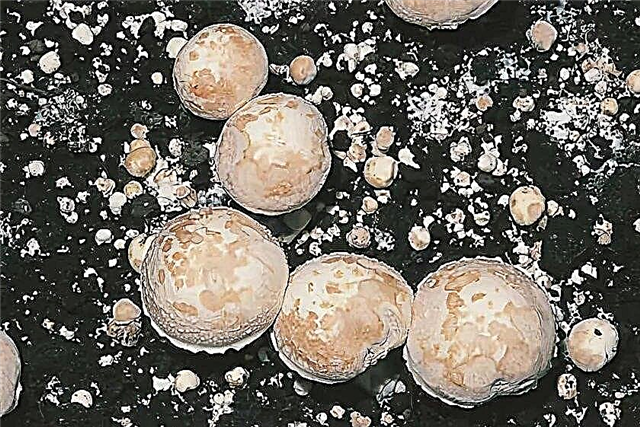
- False truffles on the substrate. With this disease, some of the fungi do not emerge, the compost becomes black, wet and smells of chlorine, and a red-brown mycelium of false truffle appears, which infects the soil. To protect against it, install thin filters on the hood, maintain the required temperature of the compost, and infected mushrooms are heat-treated.
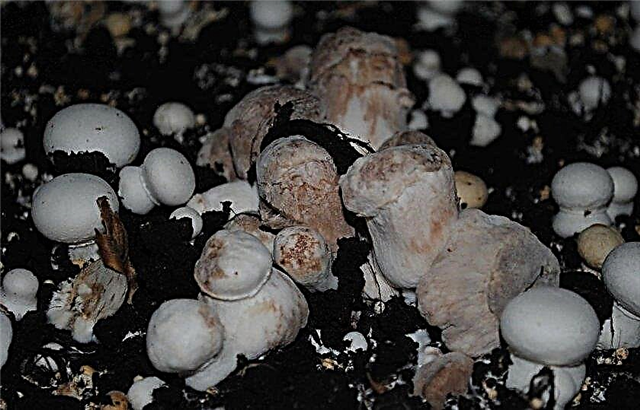
- The yellow mold forms light brown spots on the hat. It can infect compost, which leads to the unsuitability of the mycelium, or settles on equipment, due to which it spreads throughout the room. For prevention, it is necessary to install filters in the chambers, treat the equipment with a 2% formalin solution, and fight insects and rodents. And you also need to remember to wash and steam-overalls, as well as disinfect equipment and hands before applying the mycelium.

- Rusty spotting - a disease of a bacterial nature that appears when there is insufficient ventilation and humidity of the room. Even rusty spots appear on the hats. There is no cure for spotting, so the affected fungi are simply removed.

- Floating mycelium. It appears if the integumentary soil and mycelium have a different level of humidity. In this case, the mycelium sprouts up.
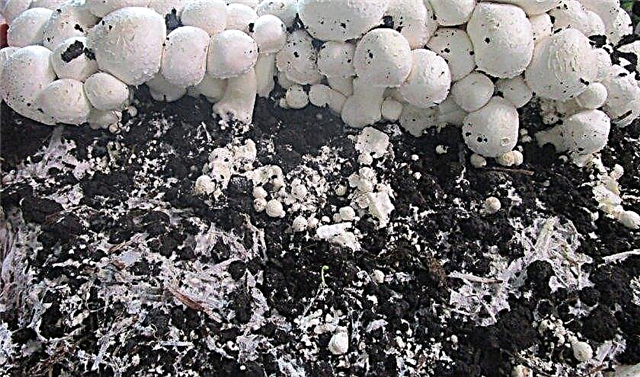
- Champignon Mummification - a viral disease in which champignons become gray, their growth stops. They must be thrown away with the infected part of the compost.

Pests can also spoil the crop, among which are most often found:
- nails
- wood lice;
- ticks;
- roundworms;
- rodents;
- mosquitoes;
- gall midges;
- humpback flies;
- insect larvae.

Considering that chemicals for insect killing can get into finished products, it is better to prevent diseases.
It includes such means:
- processing equipment and instruments;
- compost preparation according to all requirements;
- compliance with the temperature regime, ventilation of the premises;
- treatment of the integumentary soil with steam or formalin solution;
- isolation of cultivation chambers;
- disinfection of premises with a solution of lime and copper sulfate.
Harvesting
You need to collect mushrooms only by twisting. In no case should they be torn off or cut off. The pit from the mushroom is sprinkled with a coating mixture. After a complete harvest, the remains of mushrooms and spoiled mycelium are removed, compost is thrown, and the chamber is sterilized.
On one compost usually grows 6-7 crops that appear undulating. In 2-3 days, the first crop grows, and after about a week - the second. The first four are usually used on a mushroom farm, because then the activity of the mycelium decreases and productivity decreases. Champignons are collected in special containers with a capacity of 3-4 kg. They must be stored in the refrigerator at a temperature of 0 ... + 4 ° C. Under such conditions, they can be kept fresh for up to two weeks.

Champignon Sales
It is desirable to establish the sale of champignons at the initial stage of production, because their shelf life is not long.
They can be implemented in the following ways:
- to hand in wholesale for subsequent sale, while losing part of the profit, but saving time;
- sell in food markets, which takes a lot of time, but the profit in this case will be higher;
- conclude a contract for the supply of products with large supermarkets, restaurants and canneries;
- sell through eco-sites and eco-shops;
- distribute goods over the Internet using social networks or your own website.
So that buyers are more likely to choose exactly your product, you need to take care of its delivery. It will not be superfluous to pack it beautifully, if these are small batches. You can pre-purchase special containers in which mushrooms will be stored and delivered to their destination without any problems. And also, of course, the products must be of high quality, and their delivery - fast.
Possible risks
Like any business, mushroom cultivation has its pitfalls. They must be taken into account before embarking on this work.

There are such risks that can affect both the production process and the result:
- Production technology must not be violated, because the slightest deviation from the norm can lead to a decrease in productivity.
- Mushrooms are very sensitive to changes in the environment., and the slightest violation of temperature conditions, humidity, insufficient ventilation can destroy spores and destroy the crop or part of it.
- To make a good profit, it is necessary to ensure stability and take care of the distribution channels in advance. The whole process should be clearly debugged from start to finish.
- Watering should only be done by sprinklingotherwise mushrooms may not sprout.
- The price level for ready-made compost rises significantly, which can significantly increase the cost of production.
- Mycelium is better to buy ready-made and from trusted suppliers, since at home it is almost impossible to grow it. Most often, self-cultivation ends in a waste of money.
- Since the demand for mushrooms is quite high, there are more and more enterprises involved in their breeding, which greatly increases the level of competition. To be successful in this business, you need to constantly improve the quality of the product and enjoy other competitive advantages.
- Natural disasters can affect businesses, fires, emergencies, which can be protected from with the help of insurance.
Growing at home
The amount of investment in a business depends on how many finished products you plan to receive as a result. If you want to harvest a small crop, you can start working at home. A basement or other room where wooden containers or bags can be placed is perfect.
Important! With a strong increase in temperature, champignons stop growing, but then their growth is restored.
The main thing is to draw up a plan and study the demand for this type of mushroom in your region in order to start making money on it later. Like in the factory and at home, you must adhere to certain rules for equipping the premises and growing crops.

Breeding champignons may well become a good profitable business, if you take the matter seriously, take into account all the possible risks and find markets in advance. According to reviews, it is advisable to immediately test your abilities by growing a small volume of products, and only with good results expand the scale of production. What equipment is required for growing champignons











